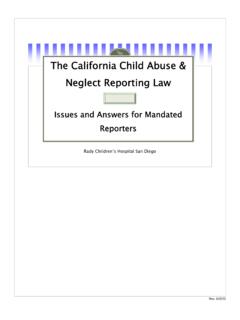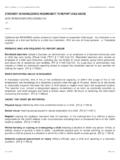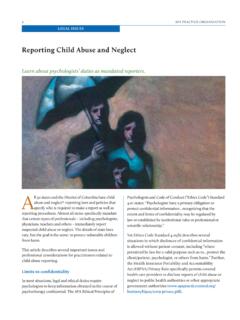Transcription of 2021 Child Abuse Assessment and Reporting
1 1 Child Abuse Assessment & Reporting 7 Hours/Units 2021 by Aspira Continuing Education. All rights reserved. No part of this material may be transmitted or reproduced in any form, or by any means, mechanical or electronic without written permission of Aspira Continuing Education. 2 Table of Contents: 1. Definitions, Statistics, and Warning 3 2. Child Abuse Screening and 32 3. Child Abuse in the Age of 55 4. Mandated Reporters and Child Abuse Reporting 665. Intervention and 156 6. Legal and Ethical 174 7. 1778. 181 , Statistics, and Warning Signs Child Abuse is the physical, psychological or sexual maltreatment of children.
2 The Centers for Disease Control and Prevention (CDC) defines Child maltreatment as, Any act or series of acts or commission or omission by a parent or other caregiver that results in harm, potential for harm, or threat of harm to a Child . Most Child Abuse occurs in the home, with a lesser amount occurring in the organizations, schools or community organizations. Currently, there are four widely recognized and identifiable categories of Child Abuse including neglect, physical Abuse , psychological/emotional Abuse , and sexual Abuse . The Mental Health Journal defines Child Abuse as Any recent act or failure to act on the part of a parent or caretaker which results in death, serious physical or emotional harm, sexual Abuse or exploitation, an act or failure to act which presents an imminent risk of serious harm.
3 Federal Law Definitions of Child Abuse and Neglect Federal legislation provides guidance to States by identifying a minimum set of acts or behaviors that define Child Abuse and neglect. The Federal Child Abuse Prevention and Treatment Act (CAPTA) (42 5106g), as amended by the CAPTA Reauthorization Act of 2010, defines Child Abuse and neglect as, at minimum: "Any recent act or failure to act on the part of a parent or caretaker, which results in death, serious physical or emotional harm, sexual Abuse or exploitation"; or "An act or failure to act which presents an imminent risk of serious harm.
4 " This definition of Child Abuse and neglect refers specifically to parents and other caregivers. A " Child " under this definition generally means a person who is younger than age 18 or who is not an emancipated minor. While CAPTA provides definitions for sexual Abuse and the special cases of neglect related to withholding or failing to provide medically indicated treatment, it does not provide specific definitions for other types of maltreatment such as physical Abuse , neglect, or emotional Abuse . While Federal legislation sets minimum standards for States that accept CAPTA funding, each State provides its own definitions of maltreatment within civil and criminal statutes.
5 4 State law definitions of Child Abuse and neglect While Federal legislation sets minimum standards for States that accept Federal funding, each State is responsible for defining Child maltreatment in State law. Definitions of Child Abuse and neglect are typically located in two places within each State's statutory code: Civil statutes provide definitions of Child maltreatment to guide individuals who are mandated to identify and report suspected Child Abuse and determine the grounds for intervention by State Child protection agencies and civil courts. Locate definitions for your State by conducting a State Statues Search on the Information Gateway website.
6 Criminal statutes define those forms of Child maltreatment that can subject an offender to arrest and prosecution in criminal courts. Many States recognize four major types of maltreatment in their definitions: neglect, physical Abuse , sexual Abuse , and emotional Abuse or neglect. Psychological and Emotional Abuse Psychological Abuse is also referred to as emotional Abuse and is a form of Abuse characterized by a person subjecting or exposing another to behavior that is psychologically harmful. It involves the willful infliction of mental or emotional anguish by threat, humiliation, or other verbal and non-verbal conduct.
7 It is often associated with situations of power imbalance, such as abusive relationships and Child Abuse . Psychological Abuse may occur as bullying of individuals by groups, often children, or it may be by one partner in a relationship. In domestic Abuse psychological Abuse nearly always precedes physical violence when this occurs, and also accompanies it. Modern technology had led to new forms of Abuse , by text messaging and online cyber-bullying. Methods of Abuse include causing fear by intimidation, threatening physical harm to self, partner, children, or partner's family or friends, destruction of pets and property, forcing isolation from family, friends, or school or work.
8 More subtle tactics include putdowns, hiding objects such as keys, then putting them back without the victim seeing, and denial that previous incidents actually happened (American Psychiatric Association, Definitions of Crisis Behavior & A Mental Disorder by DSM-5 Diagnostic & Statistical Manual of APA, & Crisis Management: NCTSN The National Child Traumatic Stress Network, Child Psychical Abuse Fact Sheet; Child Sexual Abuse Fact Sheet) 5 Methods of Manipulative Control Positive Reinforcement Carrying on the desired behavior brings rewards which may be in the form of praise, money, gifts, attention, approval or smiles.
9 In abusive relationships however it serves to lure a victim into a relationship, being used more in the early stages, and keep them from leaving when used in the cycle of Abuse . Abusers themselves receive positive reinforcement for their behavior through the benefits obtained by their behavior. Negative Reinforcement In negative reinforcement, also called aversive conditioning, unpleasant behavior by the manipulator ceases when the victim complies. Such behaviors include nagging, whining, crying, playing the victim and blaming others. This tends to cause anger resentment and frustration in the victim and can lead to a downward spiral anxiety, depression and low self esteem (Bancroft, Lundy.)
10 Why does he do that? Inside the minds of angry and controlling men Berkley Publishing Group). Intermittent or Partial Reinforcement Positive reinforcement occurring on an intermittent basis tends to lead to addiction to a relationship. It is the basis on which the gambling industry works, with slot machines paying out small amounts often enough to keep the player hooked, but not enough to show a profit, while the potential jackpot remains elusive. Unpredictable patterns of aggressive behavior, as by an aggressive manager at work, cause anxiety and keep victims striving to please (Bancroft, Lundy.





